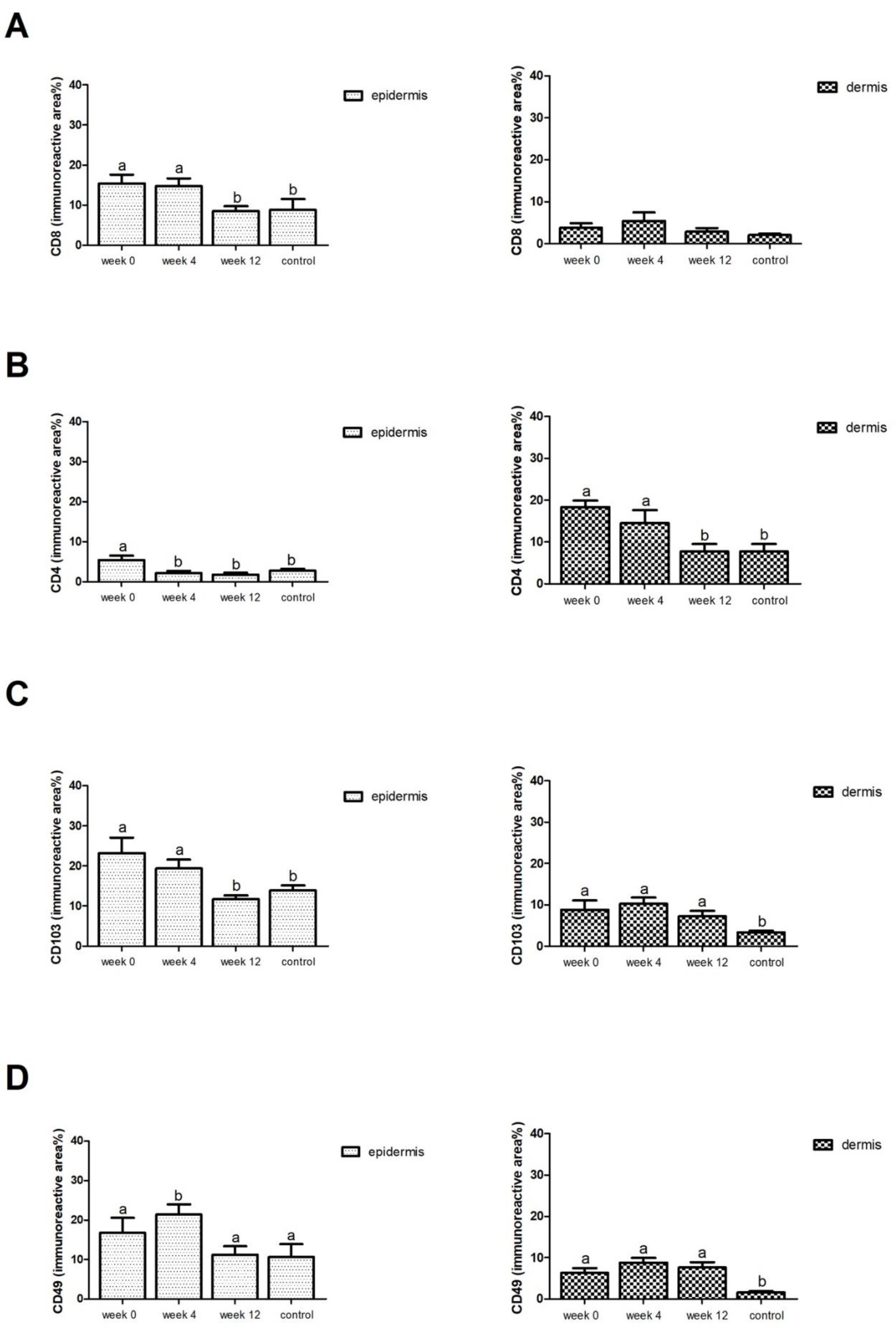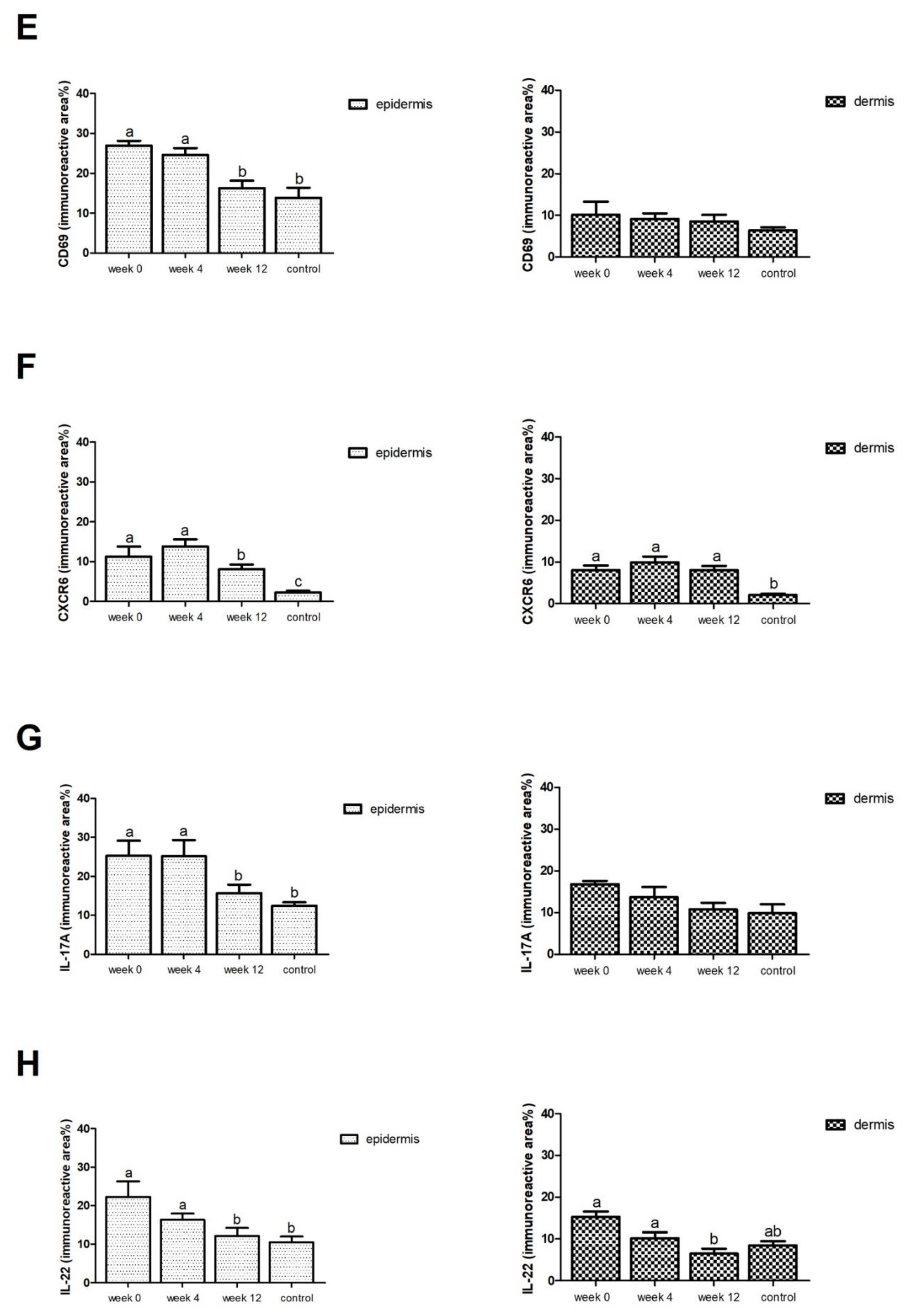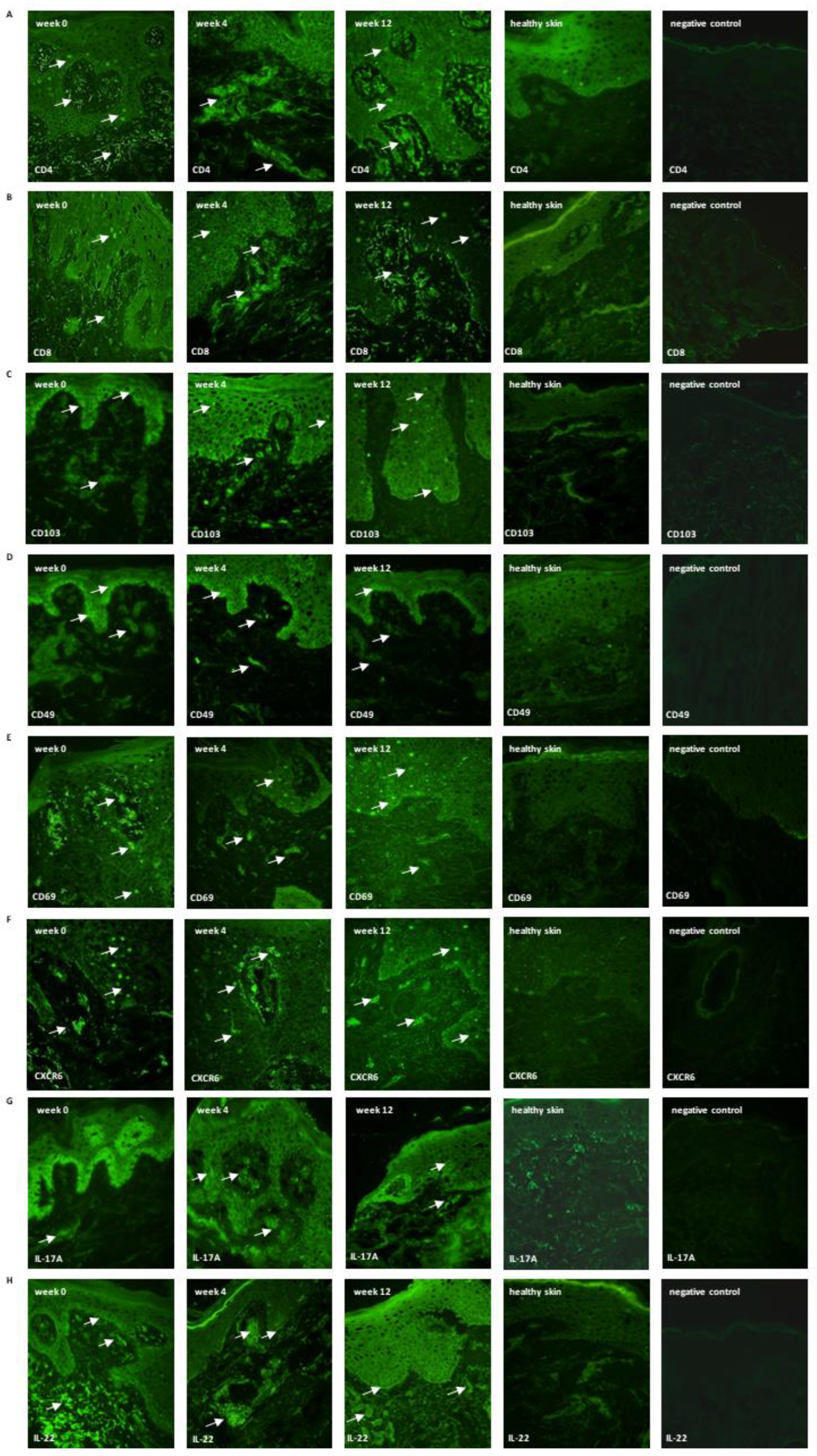The Effect of the Long-Term Calcipotriol/Betamethasone Dipropionate Local Therapy on Tissue Resident Memory Cells Markers in Psoriatic Eruptions
Abstract
:1. Introduction
2. Methods
2.1. Study Group
2.2. Clinical Samples
3. Results
3.1. Immunoreactive Area and Skin Localization of TRM Markers in Lesional Skin before Treatment in Comparison with Healthy Control (Week 0)
3.2. Immunoreactive Area and Skin Localization of TRM Markers in Lesional Skin after 4 Weeks of Treatment (Week 4)
3.3. Immunoreactive Area and Skin Localization of TRM Markers in Lesional Skin after 12 Weeks of Treatment (Week 12) in Comparison with Healthy Control
4. Discussion
5. Conclusions
6. Limitations
Author Contributions
Funding
Institutional Review Board Statement
Informed Consent Statement
Data Availability Statement
Conflicts of Interest
References
- Damiani, G.; Bragazzi, N.L.; Aksut, C.K.; Wu, D.; Alicandro, G.; McGonagle, D.; Guo, C.; Dellavalle, R.; Grada, A.; Wong, P.; et al. The global, regional, and national burden of psoriasis: Results and insights from the global burden of disease 2019 study. Front. Med. 2021, 8, 743180. [Google Scholar] [CrossRef] [PubMed]
- Fenix, K.; Wijesundara, D.K.; Cowin, A.J.; Grubor-Bauk, B.; Kopecki, Z. Immunological memory in imiquimod-induced murine model of psoriasiform dermatitis. Int. J. Mol. Sci. 2020, 19, 7228. [Google Scholar] [CrossRef] [PubMed]
- Ryan, G.E.; Harris, J.E.; Richmond, J.M. Resident Memory T Cells in Autoimmune Skin Diseases. Front. Immunol. 2021, 12, 1337. [Google Scholar] [CrossRef]
- Owczarczyk-Saczonek, A.O.; Krajewska-Włodarczyk, M.; Kasprowicz-Furmańczyk, M.; Placek, W. Immunological memory of psoriatic lesions. Int. J. Mol. Sci. 2020, 21, 625. [Google Scholar] [CrossRef] [PubMed] [Green Version]
- Sun, H.; Sun, C.; Xiao, W.; Sun, R. Tissue-resident lymphocytes: From adaptive to innate immunity. Cell. Mol. Immunol. 2019, 16, 205–215. [Google Scholar] [CrossRef] [Green Version]
- Lange, J.; Rivera-Ballesteros, O.; Buggert, M. Human mucosal tissue-resident memory T cells in health and disease. Mucosal Immunol. 2021, 15, 389–397. [Google Scholar] [CrossRef]
- Konjar, S.; Ficht, X.; Iannacone, M.; Veldhoen, M. Heterogeneity of Tissue Resident Memory T cells. Immunol. Lett. 2022, 245, 1–7. [Google Scholar] [CrossRef]
- Kasprowicz-Furmańczyk, M.; Czerwińska, J.; Placek, W.; Owczarczyk-Saczonek, A. Assessment of the tissue resident memory cells in lesional skin of patients with psoriasis and in healthy skin of healthy volunteers. Int. J. Environ. Res. Public Health 2021, 18, 11251. [Google Scholar] [CrossRef]
- Di Meglio, P.; Villanova, F.; Navarini, A.A.; Mylonas, A.; Tosi, I.; Nestle, F.O.; Conrad, C. Targeting CD8+ T cells prevents psoriasis development. J. Allergy Clin. Immunol. 2016, 138, 274–276. [Google Scholar] [CrossRef] [Green Version]
- Vu, T.T.; Koguchi-Yoshioka, H.; Watanabe, R. Skin-resident memory t cells: Pathogenesis and implication for the treatment of psoriasis. J. Clin. Med. 2021, 10, 3822. [Google Scholar] [CrossRef]
- Cheuk, S.; Schlums, H.; Gallais Sérézal, I.; Martini, E.; Chiang, S.C.; Marquardt, N.; Gibbs, A.; Detlofsson, E.; Introini, A.; Forkel, M.; et al. CD49a Expression Defines Tissue-Resident CD8+ T Cells Poised for Cytotoxic Function in Human Skin. Immunity 2017, 46, 287–300. [Google Scholar] [CrossRef] [PubMed] [Green Version]
- Leska, A.; Kiezun, J.; Kaminska, B.; Dusza, L. Estradiol concentration and the expression of estrogen receptors in the testes of the domestic goose (Anser anser f. domestica) during the annual reproductive cycle. Domest. Anim. Endocrinol. 2015, 51, 96–104. [Google Scholar] [CrossRef] [PubMed]
- Kurihara, K.; Fujiyama, T.; Phadungsaksawasdi, P.; Ito, T.; Tokura, Y. Significance of IL-17A-producing CD8+CD103+ skin resident memory T cells in psoriasis lesion and their possible relationship to clinical course. J. Dermatol. Sci. 2019, 95, 21–27. [Google Scholar] [CrossRef] [PubMed]
- Samarasekera, E.J.; Sawyer, L.; Wonderling, D.; Tucker, R.; Smith, C.H. Topical therapies for the treatment of plaque psoriasis: Systematic review and network meta-analyses. Br. J. Dermatol. 2013, 168, 954–967. [Google Scholar] [CrossRef]
- Nestle, F.O.; Kaplan, D.H.; Barker, J. Mechanisms of disease: Psoriasis. N. Engl. J. Med. 2009, 361, 496–509. [Google Scholar] [CrossRef]
- Kim, J.; Krueger, J.G. The Immunopathogenesis of Psoriasis. Dermatol. Clin. 2015, 33, 13–23. [Google Scholar] [CrossRef]
- Nograles, K.E.; Zaba, L.C.; Guttman-Yassky, E.; Fuentes-Duculan, J.; Suarez-Farinas, M.; Cardinale, I.; Khatcherian, A.; Gonzales, J.; Pierson, K.C.; White, T.R.; et al. Th17 cytokines interleukin (IL)-17 and IL-22 modulate distinct inflammatory and keratinocyte-response pathways. Br. J. Dermatol. 2008, 159, 1092–1102. [Google Scholar] [CrossRef] [Green Version]
- Adamczyk, M.; Bartosińska, J.; Krasowska, D. Efficacy and safety of agents containing betamethasone dipropionate and calcipotriol in topical therapy of psoriasis. Przegl. Dermatol. 2018, 105, 434–450. [Google Scholar] [CrossRef]
- Guillot, X.; Semerano, L.; Saidenberg-Kermanach, N.; Falgarone, G.; Boissier, M.C. Vitamin D and inflammation. Joint Bone Spine 2010, 77, 552–557. [Google Scholar] [CrossRef]
- Lovato, P.; Norsgaard, H.; Tokura, Y.; Røpke, M.A. Calcipotriol and betamethasone dipropionate exert additive inhibitory effects on the cytokine expression of inflammatory dendritic cell-Th17 cell axis in psoriasis. J. Dermatol. Sci. 2016, 81, 153–164. [Google Scholar] [CrossRef] [Green Version]
- Fujiyama, T.; Ito, T.; Umayahara, T.; Ikeya, S.; Tatsuno, K.; Funakoshi, A.; Hashizume, H.; Tokura, Y. Topical application of a vitamin D3 analogue and corticosteroid to psoriasis plaques decreases skin infiltration of TH17 cells and their ex vivo expansion. J. Allergy Clin. Immunol. 2016, 138, 517–528. [Google Scholar] [CrossRef] [PubMed] [Green Version]
- Jadali, Z.; Eslami, M.B. T cell immune responses in psoriasis. Iran. J. Allergy Asthma Immunol. 2014, 13, 220–230. [Google Scholar] [PubMed]
- Dyring-Andersen, B.; Bonefeld, C.M.; Bzorek, M.; Lovendorf, M.B.; Lauritsen, P.H.; Skov, L.; Geisler, C. The Vitamin D Analogue Calcipotriol Reduces the Frequency of CD8+IL-17+ T Cells in Psoriasis Lesions. Scand. J. Immunol. 2015, 82, 84–91. [Google Scholar] [CrossRef]
- Vissers, W.H.P.; Berends, M.; Muys, L.; van Erp, P.E.J.; de Jong, E.M.G.J.; van de Kerkhof, P.C.M. The effect of the combination of calcipotriol and betamethasone dipropionate versus both monotherapies on epidermal proliferation, keratinization and T-cell subsets in chronic plaque psoriasis. Exp. Dermatol. 2004, 13, 106–112. [Google Scholar] [CrossRef] [PubMed]
- van der Vleuten, C.J.M.; de Jong, E.M.G.J.; van de Kerkhof, P.C.M. Epidermal differentiation characteristics of the psoriatic plaque during treatment with calcipotriol. Arch. Dermatol. Res. 1996, 288, 366–372. [Google Scholar] [CrossRef] [PubMed]
- Kvist, P.H.; Svensson, L.; Hagberg, O.; Hoffmann, V.; Kemp, K.; Røpke, M.A. Comparison of the effects of vitamin D products in a psoriasis plaque test and a murine psoriasis xenograft model. J. Transl. Med. 2009, 7, 107. [Google Scholar] [CrossRef] [Green Version]
- Reichrath, J.; Muller, S.M.; Kerber, A.; Baum, H.P.; Bahmer, F.A. Biologic effects of topical calcipotriol (MC 903) treatment in psoriatic skin. J. Am. Acad. Dermatol. 1997, 36, 19–28. [Google Scholar] [CrossRef]
- Ikeda, U.; Wakita, D.; Ohkuri, T.; Chamoto, K.; Kitamura, H.; Iwakura, Y.; Nishimura, T. 1α,25-Dihydroxyvitamin D3 and all-trans retinoic acid synergistically inhibit the differentiation and expansion of Th17 cells. Immunol. Lett. 2010, 134, 7–16. [Google Scholar] [CrossRef]
- Owczarczyk-Saczonek, A.; Kasprowicz-Furmańczyk, M.; Czerwińska, J.; Krajewska-Włodarczyk, M.; Placek, W. The effect of therapy on TRM in psoriatic lesions. Adv. Dermatol. Allergol. 2022, 38, 209–220. [Google Scholar] [CrossRef]
- Lebwohl, M.; Thaçi, D.; Warren, R.B. Addressing challenges associated with long-term topical treatment and benefits of proactive management in patients with psoriasis. J. Eur. Acad. Dermatol. Venereol. 2021, 35, 35–41. [Google Scholar] [CrossRef]
- Lebwohl, M.; Kircik, L.; Lacour, J.P.; Liljedahl, M.; Lynde, C.; Holst Morch, M.; Papp, K.A.; Perrot, J.L.; Stein Gold, L.; Takhar, A. Twice-weekly topical calcipotriene/betamethasone dipropionate foam as proactive management of plaque psoriasis increases time in remission and is well tolerated over 52 weeks (PSO-LONG trial). J. Am. Acad. Dermatol. 2021, 84, 1269–1277. [Google Scholar] [CrossRef] [PubMed]



| Week 0 | Week 4 | Week 12 | Changes from Week 0 to 12 (%) | Healthy Control | ||||||
|---|---|---|---|---|---|---|---|---|---|---|
| Epidermis | Dermis | Epidermis | Dermis | Epidermis | Dermis | Epidermis | Dermis | Epidermis | Dermis | |
| CD8 | 15.43 ± 2.1 | 3.83 ± 1.0 | 14.74 ± 1.9 | 5.46 ± 2.1 | 8.51 ± 1.2 | 2.84 ± 0.9 | ↓45 * | ↓15 | 8.83 ± 2.68 | 2.04 ± 0.33 |
| CD4 | 5.46 ± 1.1 | 18.34 ± 1.5 | 2.17 ± 0.5 | 14.5 ± 3.0 | 1.78 ± 0.4 | 7.71 ± 1.8 | ↓67 * | ↓57 * | 2.77 ± 0.49 | 7.71 ± 1.80 |
| CD103 | 23.26 ± 3.8 | 8.81 ± 2.2 | 19.38 ± 2.1 | 10.25 ± 1.5 | 11.72 ± 0.9 | 7.23 ± 1.3 | ↓49 * | ↓17 | 13.88 ± 1.28 | 3.37 ± 0.42 |
| CD49 | 16.79 ± 3.7 | 6.31 ± 1.1 | 21.40 ± 2.5 | 8.78 ± 1.1 | 11.23 ± 2.1 | 7.6 ± 1.2 | ↓33 * | ↑20 | 10.66 ± 3.23 | 1.55 ± 0.34 |
| CD69 | 26.98 ± 1.1 | 10.16 ± 3.0 | 24.57 ± 1.7 | 9.1 ± 1.3 | 16.31 ± 1.8 | 8.58 ± 1.5 | ↓39 * | ↓15 | 13.89 ± 2.51 | 6.39 ± 0.69 |
| CXCR6 | 11.21 ± 2.5 | 8.02 ± 1.1 | 13.7 ± 1.8 | 9.92 ± 1.3 | 8.10 ± 1.1 | 8.03 ± 0.9 | ↓27 * | 0 | 2.24 ± 0.41 | 2.05 ± 0.33 |
| IL17 | 25.27 ± 3.8 | 16.76 ± 0.8 | 25.17 ± 4.1 | 13.69 ± 2.4 | 15.71 ± 2.1 | 10.76 ± 1.5 | ↓37 * | ↓35 | 12.45 ± 0.94 | 9.85 ± 2.14 |
| IL22 | 22.29 ± 3.8 | 15.26 ± 1.3 | 16.29 ± 1.6 | 10.22 ± 1.3 | 12.16 ± 2.0 | 6.52 ± 1.1 | ↓45 * | ↓57 * | 10.54 ± 1.44 | 8.45 ± 1.03 |
| Week 0 | Week 4 | Week 12 | Changes from Week 0 to 12 (%) | ||
|---|---|---|---|---|---|
| PASI | 6.91 ± 0.8 | 3.32 ± 0.59 | 2.1 ± 0.34 | ↓69 * | p = 0.0008 |
| BSA | 8.13 ± 1.09 | 5.62 ± 0.98 | 3.12 ± 0.35 | ↓61 * | p = 0.002 |
| DLQI | 11.18 ± 0.86 | 8 ± 1.11 | 6 ± 1.08 | ↓46 * | p = 0.02 |
Publisher’s Note: MDPI stays neutral with regard to jurisdictional claims in published maps and institutional affiliations. |
© 2022 by the authors. Licensee MDPI, Basel, Switzerland. This article is an open access article distributed under the terms and conditions of the Creative Commons Attribution (CC BY) license (https://creativecommons.org/licenses/by/4.0/).
Share and Cite
Kasprowicz-Furmańczyk, M.; Czerwińska, J.; Placek, W.; Owczarczyk-Saczonek, A. The Effect of the Long-Term Calcipotriol/Betamethasone Dipropionate Local Therapy on Tissue Resident Memory Cells Markers in Psoriatic Eruptions. Int. J. Environ. Res. Public Health 2022, 19, 8345. https://doi.org/10.3390/ijerph19148345
Kasprowicz-Furmańczyk M, Czerwińska J, Placek W, Owczarczyk-Saczonek A. The Effect of the Long-Term Calcipotriol/Betamethasone Dipropionate Local Therapy on Tissue Resident Memory Cells Markers in Psoriatic Eruptions. International Journal of Environmental Research and Public Health. 2022; 19(14):8345. https://doi.org/10.3390/ijerph19148345
Chicago/Turabian StyleKasprowicz-Furmańczyk, Marta, Joanna Czerwińska, Waldemar Placek, and Agnieszka Owczarczyk-Saczonek. 2022. "The Effect of the Long-Term Calcipotriol/Betamethasone Dipropionate Local Therapy on Tissue Resident Memory Cells Markers in Psoriatic Eruptions" International Journal of Environmental Research and Public Health 19, no. 14: 8345. https://doi.org/10.3390/ijerph19148345
APA StyleKasprowicz-Furmańczyk, M., Czerwińska, J., Placek, W., & Owczarczyk-Saczonek, A. (2022). The Effect of the Long-Term Calcipotriol/Betamethasone Dipropionate Local Therapy on Tissue Resident Memory Cells Markers in Psoriatic Eruptions. International Journal of Environmental Research and Public Health, 19(14), 8345. https://doi.org/10.3390/ijerph19148345








